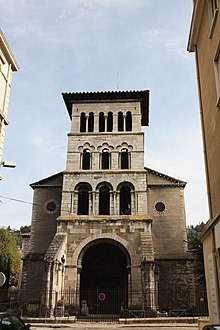
Vienne is a town in southeastern France, located 35 kilometres (22 mi) south of Lyon, at the confluence of the Gère and the Rhône. It is the fourth-largest commune in the Isère department, of which it is a subprefecture alongside La Tour-du-Pin. Vienne was a major centre of the Roman Empire under the Latin name Vienna.

Saint-Julien-le-Pauvre, in full Église Saint-Julien-le-Pauvre, is a Melkite Greek Catholic parish church in Paris, France, and one of the city's oldest religious buildings. Begun in Romanesque style during the 12th century, most of ist is Primary Gothic. It is situated in the 5th arrondissement, on the Left Bank of the Seine River, about 500 meters away from the Musée de Cluny and in the proximity of the Maubert-Mutualité Paris Métro station. It shares a city block with the Square René Viviani.

The Church of Saint-Germain-des-Prés is a Roman Catholic parish church located in the Saint-Germain-des-Prés quarter of Paris. It was originally the church of a Benedictine abbey founded in 558 by Childebert I, the son of Clovis, King of the Franks. It was destroyed by the Vikings, rebuilt, and renamed in the 8th century for Saint Germain, an early Bishop of the city. it was rebuilt with elements in the new Gothic style in the eleventh century, and was given the first flying buttresses in Paris in the 12th century. It is considered the oldest existing church in Paris.

Saint-Pierre de Montmartre is the second oldest surviving church in Paris, after the Abbey of Saint-Germain-des-Pres. It is one of the two main churches on Montmartre, the other being the more famous 19th-century Sacré-Cœur Basilica, just above it. Saint-Pierre de Montmartre, begun in 1133, was the church of the prestigious Montmartre Abbey, destroyed in the French Revolution.

Maillezais Cathedral is a ruined Roman Catholic church in the commune of Maillezais in the Vendée, France. Formerly the site of the Abbey of Saint-Pierre, the site grew from the 10th century abbey to the cathedral completed in the 15th century, with the many structures at the site abandoned by the end of the 17th century. Today's ruins consist of a cathedral, refectory, dormitory, kitchen, cellars, turrets and ramparts. The cathedral has been declared a heritage monument in reflection of its Romanesque and Gothic architectural form. It was designated a monument historique on 30 January 1924. The cathedral belonged to the Diocese of Luçon, with Roman Rites, and with St. Peter as the patron saint.
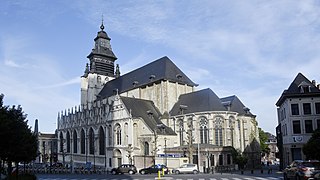
The Church of Our Lady of the Chapel, or the Chapel Church, is a Roman Catholic church located in the Marolles/Marollen district, in the historic centre of Brussels, Belgium. It is dedicated to Our Lady of the Chapel.

Beaulieu-sur-Dordogne is a commune in the Corrèze department in the Nouvelle-Aquitaine region, central France. Beaulieu is a medieval city, originally dominated by its great abbey of St Pierre, of which only the abbey church remains. On 1 January 2019, the former commune Brivezac was merged into Beaulieu-sur-Dordogne.
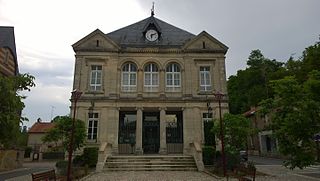
Vienne-le-Château is a commune in the Marne department in north-eastern France.

The Church of St. James on Coudenberg is a Roman Catholic church located on the historic Place Royale/Koningsplein, in the Royal Quarter of Brussels, Belgium. It is dedicated to Saint James, one of the Twelve Apostles of Jesus.
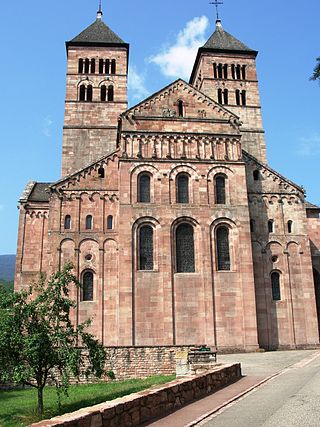
The Route Romane d'Alsace is a tourist itinerary designed by the Association Voix et Route Romane to link both the well-known and the more secret examples of Romanesque architecture of Alsace, in an itinerary of 19 stages, linking churches, abbeys and fortresses, that range from the first Romanesque structures of Alsace at the abbey church of Saint Trophime, Eschau, into the 13th century, and the beginning of Gothic architecture in Alsace. From north to south, the Route Romane d'Alsace traverses the Bas-Rhin and the Haut-Rhin, passing through:

Redon Abbey, or Abbey of Saint-Sauveur, Redon, in Redon in the present Ille-et-Vilaine, Brittany, France, is a former Benedictine abbey founded in 832 by Saint Conwoïon, at the point where the Oust flows into the Vilaine, on the border between Neustria and Brittany.

Saint-Jacques du Haut-Pas is a Roman Catholic parish church in Paris, France. The church is located at the corner of Rue Saint-Jacques and Rue de l'Abbé de l'Épée in the 5th arrondissement of Paris. The first church on the site, a monastery chapel, was built in 1360. The present church was completed in 1685. The church is named for Saint-Jacques Du-Haut-Pas,", a cousin of Christ and the first bishop of Jerusalem, who was martyred in the year 60.It was registered as an historical monument on 4 June 1957.
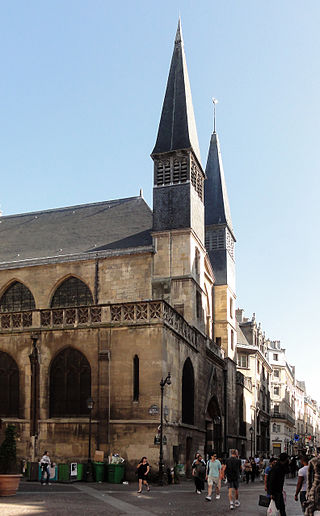
The Église Saint-Leu-Saint-Gilles de Paris is a Roman Catholic parish church in the 1st arrondissement of Paris. It has housed the relics of the Empress Saint Helena, mother of Constantine, since 1819, for which it remains a site of veneration in the Roman Catholic and Eastern Orthodox churches. In 1915 the French Ministry of Culture listed it as a monument of historical value.

Notre-Dame de la Couture is a church in Le Mans. Formerly the abbey church of Saint-Pierre de la Couture Abbey, it is in the centre of the present-day town. It mainly dates to the 12th century - it shows many similarities to Le Mans Cathedral and Angers Cathedral, both built at about the same time. Its large westwork is framed by two differently-designed towers and other former abbey buildings abut the church, with the prefecture for Sarthe now occupying those on the south side. It was classed as a historic monument in 1840.

Saint Trophimus' Church is a Romanesque church in Eschau, a small town in the suburbs of Strasbourg, the historical capital of Alsace. The church is dedicated to Trophimus of Arles.

Romanesque architecture appeared in France at the end of the 10th century, with the development of feudal society and the rise and spread of monastic orders, particularly the Benedictines, which built many important abbeys and monasteries in the style. It continued to dominate religious architecture until the appearance of French Gothic architecture in the Île-de-France between about 1140 and 1150.

Église Saint-Pierre-et-Saint-Paul is the Catholic parish church of the village of Neuwiller-lès-Saverne, in the Bas-Rhin department of France.

Solignac Abbey, or the Abbey of Saint-Peter and Saint Paul of Solignac, is an abbey in Solignac, near Limoges, in Haute-Vienne. It was founded around 631 AD by Saint Eligius (Éloi). The present buildings date to the 12th century, but have been modified many times since then. The abbey was dissolved during the French Revolution and the buildings were put to new uses, including a prison, boarding school, porcelain factory and seminary. As of 2021 there were plans to restore it back to its original function as a monastery.

The Saint Cydroine Church is a Romanesque church dating from the eleventh and twelfth centuries. It is among the oldest in the Yonne department, located in the town of Laroche-Saint-Cydroine in France.

The Collegiate Church of Saint-Barnard is a former collegiate church in Romans-sur-Isère, France, founded in 838 by Saint Bernard of Vienne on the banks of the Isère river.
